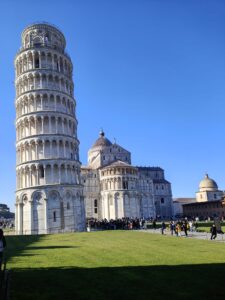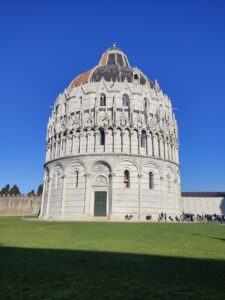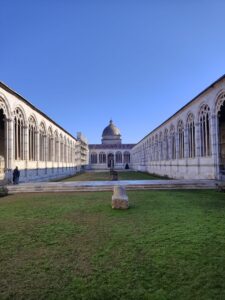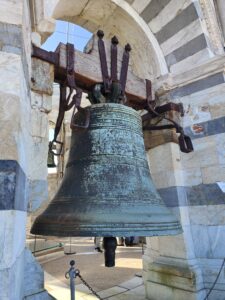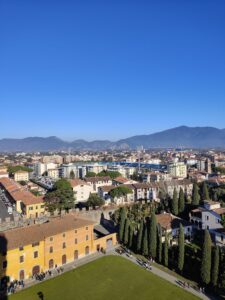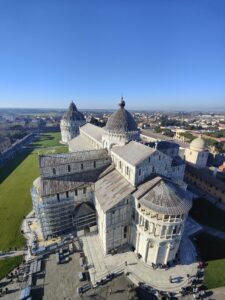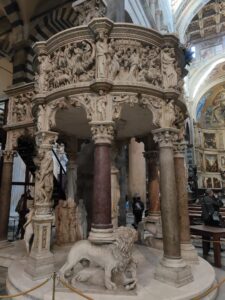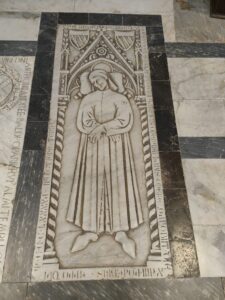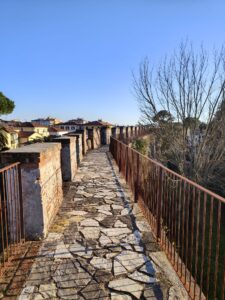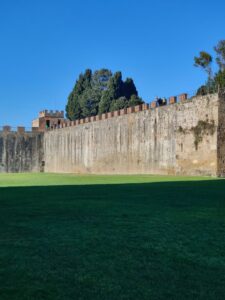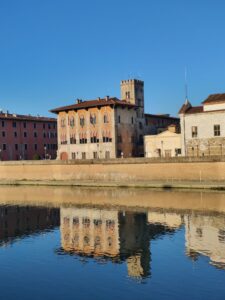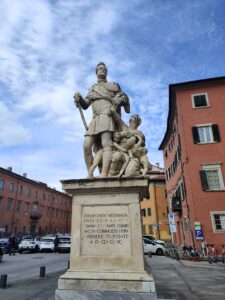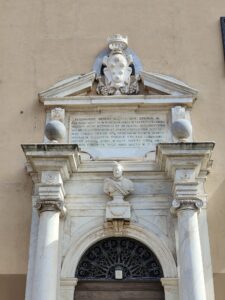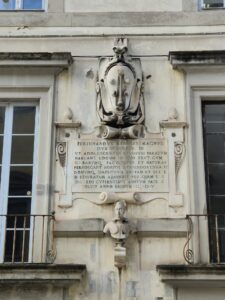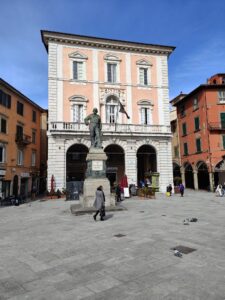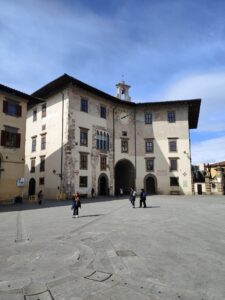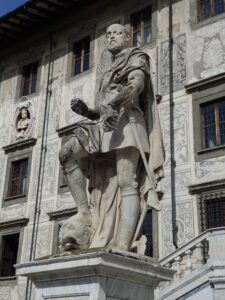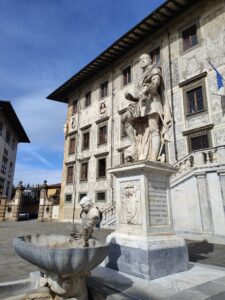Pisa – city in Italy – Tuscany
Piazza del Duomo – square of miracles
To many a visitor, Pisa is the place to pose. I start my visit to Pisa at the iconic tower which is Italy’s famous landmark. It certainly draws a crowd. The cobbled walkway between the tower and the rest of the city is a sorry state of exuberance. Crowded with wannabee influencers, they fight for a space, which hopefully excludes others from their shot.
Flaunting their search of potential Instagram fame or becoming the next viral sensation is the name of the game. As poses are engineered and the weary photographer is often sent back to take another shot from a different angle, it is hard not to fall into the trap of copying the latest photo trend. But sneak away from the obsessive self-gratification and you find there is more to Pisa than a photo op.
I would hate to guess at how many people just visit to “get that picture”. Can you say you’ve really visited if you haven’t climbed the tower? Spontaneity is a distant memory these days; turning up on a whim is a fool’s dream. The ease that pre booking gives you is stark contrast to the mayhem of people queuing and trying to get tickets. Some leave with the satisfaction of climbing the tower and visiting the cathedral. Others you imagine are equally satisfied with their picture!
Tower of Pisa aka ‘Leaning Tower of Pisa’
The tower is a real tick in the tourist checklist. Climbing the 294 steps up the tower is surely a must! Even without it’s lean the tower is rather impressive. The tower was built to house the cathedral’s bells and is unusual as it is set completely apart and to the rear of the cathedral.
There are some similarities between the ‘Tower of Pisa’ and Giotto’s campanile in Florence. Building began on the ‘Tower of Pisa’ in 1174 by Bonanno Pisano. Work came to a halt when the tower started sinking into the ground before it was finally finished in the 14th century. The belltower is home to 7 bells. Walking around the lopsided top floor is a weird sensation. The view, though, is richly rewarding and shows impressive views of both city and cathedral.
The blogs of my meanderings have often mentioned a cross like shape when visiting cathedrals. When looking from above you immediately see the Latin-cruciform plan. The sheer size of the cathedral is impressive and immediately shows what the Florentines were competing against. Of the bell towers visited thus far around Italy (Bologna & Florence), is this the better one?
Pisa Cathedral – Metropolitan Cathedral of the Assumption of Mary
Construction of the cathedral began as early as 1064. Stepping inside shows more clearly the age of the building as examples of plain and simple Romanesque architecture are evident. Further investigation shows influence from around the world. Those influences come from the Moors, Byzantine, Islamic and Armenian cultures – a true testament of the diverse wealth created by the merchants during Pisa’s maritime republic.
Construction finished in 1092, and consecration took place in 1118. Enlargements took place over time until a devasting fire broke out in 1595. This took the roof off, damaged the entrance doors and many pieces of art. The doors seen today are not those of Bonanno but made by the artists of the school of Giambologna.
The pulpit in Pisa cathedral is incredible. Carved by Giovanni Pisano in 1302 and completed it in 1311. The pulpit is certainly elaborate with the carvings showing the main episodes of the life of Christ.
Pisa Baptistery of St. John and Camposanto Monumentale
Once you have completed visits to the cathedral and its famous tower take the time to explore the two other points of interest that may be seen on purchase of a full ticket – the largest baptistery in Italy and the Camposanto.
The baptistery is perhaps best viewed from the outside where you will notice that the roof is unusual. The roof is split into two halves. One half of the roof faces the sea and is finished in rich red tiles that glow at sunset. The other half is covered in lead and catches the rays of the rising sun. It’s hard to believe but the baptistry is taller than the leaning tower.
Inside the baptistry is rather plain and simple. 12 columns which represent the 12 apostles tower up to the upper gallery which is the best place to listen to acoustics of melodies that are performed daily. Also, on the upper floor, there is one window which offers a fantastic view (and perfect photo spot) of the cathedral front and tower behind.
Less visited of all the 4 sites is the Camposanto Monumentale (monumental churchyard). Inside you will find evidence of medieval paintings and sculptures. It was also decided that the Roman coffins should be housed rather than randomly scattered around the Duomo. Built in 1276 at the behest of Archbishop Federigo Visconti the architecture is outstanding. Legend has it that the churchyard was built on a mound of soil brought back from the Holy Land in 12th century.
Mura di Pisa – Pisa’s City Walls
After completing the ‘square of miracles’ take time to explore the rest of the city. From the square an alternative and more serene route is to walk the old city walls. Entrance is located just behind the Camposanto where a small entrance fee is required. The towering 11m high medieval walls provide a different and interesting perspective of the city. Along the 3km route there aren’t many points of interest once you leave the square of miracles.
The end of the city walk brings us out on the edge of the River Arno, the famous river that flows from its source in the Tuscan Apennines through Florence and now Pisa. On this fine day its simmering reflections greet us with our weary limbs as we head to the city centre in search of refreshments. Our exhaustion and lack of time mean visits are not made to some of the interesting and historical places along the river. The Medici family villa was easily recognisable on the other side of the river as we walked past. You shouldn’t ignore Chiesa di Santa Maria della Spina – sadly it wasn’t open when we passed.
Medici in Pisa
Pisa is often referred to as the other Medici capital. In the winter they would hold their court in the city. With hindsight I should have acquainted myself with details of the influence the Medici family over the city before the visit and should have dedicated more time to explore this part of their history.
We stop close to the Logge dei Banchi, formerly Logge dei Mercanti or del Buontalenti, which was built by Grand Duke Ferdinando I de’ Medici in 1606. The Medici coat of arms is emblazoned on the outside of the building. We then cross the river and head back into the city and back towards the square of miracles.
Directly opposite us on the other side of the river is Piazza Garibaldi which, as you guess, is named after the statue of the general who played a key role in the unification of Italy. This is another major part of Italian history I need to learn about. I can recall seeing his statue in Bologna and now Pisa – evidently, he was a man of clear importance in Italian history.
We meander our way along the streets in a northernly direction. Having no plan and getting lost is part of the fun. Did you know that Pisa was the birthplace of Galileo Galilei? His grave was discovered in Santa Croce in Florence. Somehow, we stumble upon a statue to Ferdinando I de’ Medici who invested much into the university of Pisa. Further evidence of his involvement with the university was seen when a noticeable doorway was discovered of Ferdinando. The Medici coat of arms is noticeable across the city.
Piazza dei Cavalieri
There is evidence of the renaissance in the beautiful Piazza dei Cavalieri. The second most famous piazza in the city is also known as ‘knights square’. A commanding presence in the middle of the square is a statue of Cosimo de’ Medici. The square is surrounded by beautiful buildings which were designed by Cosimo’s architect Vasari. As time has beaten me, I leave through the Piazza through the archway of Palazzo dell’Orologio head back to the square of miracles.
Pisa Summary
I leave Pisa exhausted from a long day walking and exploring. Treading the beaten path can be frustrating and exasperating. Trying to find the untrodden path always brings much joy and reward. The fine weather of course helps.
For me, there is a lot more to Pisa than meets the eye. I’m grateful that I didn’t just come to Pisa to see the tower and get a picture. I can leave knowing that I climbed to the top, visited the cathedral, baptistery and Camposanto Monumentale. Most of all I’m proud to have explored further the beautiful city of Pisa and what it had to offer. I’m fast learning that my fascination with the Medici family shouldn’t be isolated to Florence, and why should it? After all they were the Grand dukes of Tuscany and Tuscany is larger than Florence. I shouldn’t be surprised to find evidence of the Medici influence in each place that I visit in Tuscany.
Pisa supposedly has a rich maritime history, which is hard to believe as not one boat or harbour was seen on my visit. Further exploration is clearly required. It is hoped that such explorations will provide the valuable information to be able to write about the city in full detail and cover its history.
Let’s see what other delights Tuscany has to offer and how far the Medici influence spread.



